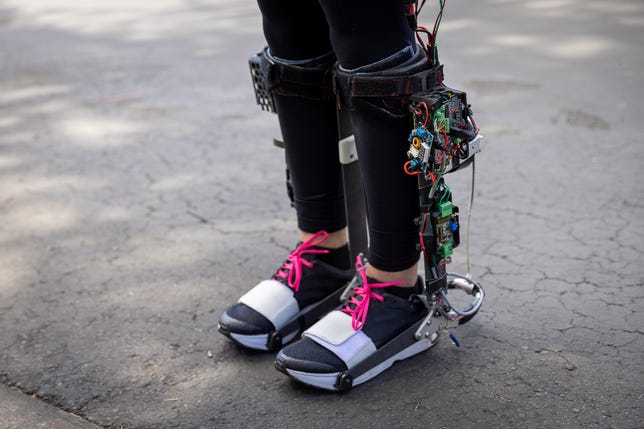The future of walking assistance might not come from a cane or a walking frame, but instead from a pair of robotic exoskeleton boots.
That’s the vision of researchers at Stanford University’s Biomechatronics Lab, who’ve developed their first untethered exoskeleton designed to give people a motorized boost to their step as they walk. I’ve come to Stanford for CNET’s What the Future video series to put the exoskeletons through their paces (quite literally) and see if my speedy walk can be powered up, superhero style.
Patrick Slade, the postdoctoral scholar behind the exoskeleton design, has given me a lot of hope on that front.

Kurt Hickman/Stanford University
“This is the real-world Iron Man,” he says. “It’s basically a motorized shoe. … By replacing your calf function with a motor, we can really put a boost in your step and help you walk more easily and more quickly.”
The exoskeleton fits onto your foot with a regular shoe (albeit one retrofitted with sensors), which is attached to the calf via a carbon fibre brace and wires. As you walk, a motor behind the calf winds up a cable connected to the shoe, allowing you to push off the ground more easily.
But the added secret to this exoskeleton is that it learns the way you walk, the longer you wear it. A machine learning system built in to each boot takes input from sensors across the exoskeleton to understand how your ankle is moving and when your foot is making contact with the ground. It then adapts the motor and power to customize the lift to your gait.
That machine-learning system was developed with the help of “exoskeleton emulators” in the Biomechatronics Lab. These systems are essentially big exoskeletons set up permanently over treadmills in the lab, allowing the researchers to test different iterations of design, without having to physically build prototypes.
“You can think about this as like a virtual reality system for your legs,” says Steve Collins, associate professor of mechanical engineering at Stanford, and the lab lead. “We program in the device that we think might help a person, we put on the emulator, they feel what it would be like to walk with that device. And then if it helps… we refine the design. If it doesn’t, then we ditch that and try something new.”
But testing in a lab is one thing, testing out in the real world is a whole different ball game. I headed out on the Stanford campus with Patrick Slade to put the exo-boots to the test. After lacing up my shoes, strapping on the leg braces and clipping the battery pack around my waist, I was ready to go.
Within just two or three steps, I could feel the motors on my legs whir into gear and start to push me up off the ground. I felt less like Iron Man (no blasting off into space just yet) and a lot more like there was a robot controlling my feet.
There was no doubt I got a spring in my step. But the problem with getting used to these exoskeletons wasn’t with the machine — it was with me. My brain made it harder than I thought it would be. Just like pulling a muscle in your leg can make you unconsciously change the way you walk as you adjust your gait to compensate, my legs and my brain didn’t know what to make of this sudden new assistance. I started to walk a bit like a robot. I felt like Jack Donaghy in 30 Rock when he suddenly forgets how to move like a normal person.
According to Patrick Slade, even though the exoskeleton is quick to learn, humans take longer. Patients and test subjects are normally given training in the lab, and their bodies and brains normally take a few hours to adjust to the assistance. I was speed-running this in less than an hour.
Still, I could absolutely feel the difference. And the biggest change came when I turned the boots off. Suddenly my legs felt like dead weight — like I’d pulled myself out of a swimming pool and gone from weightless to feeling the full force of gravity.
Testing these prototypes out in the space of an afternoon, I got a real look at just how much this research could make a difference. Slade and the team hope these kinds of assistive devices — high-tech wearables that adapt to the users — could help elderly patients or those with walking difficulties get new levels of mobility that are perfectly targeted to their needs.
To see the exoskeletons in action, check out this week’s episode of What the Future, at the top of this article.

